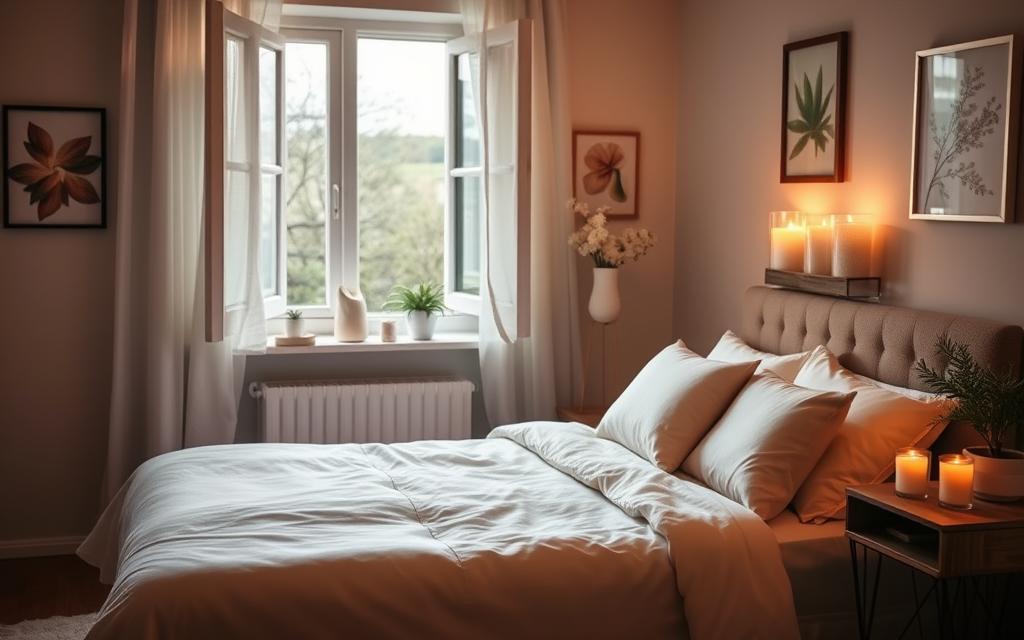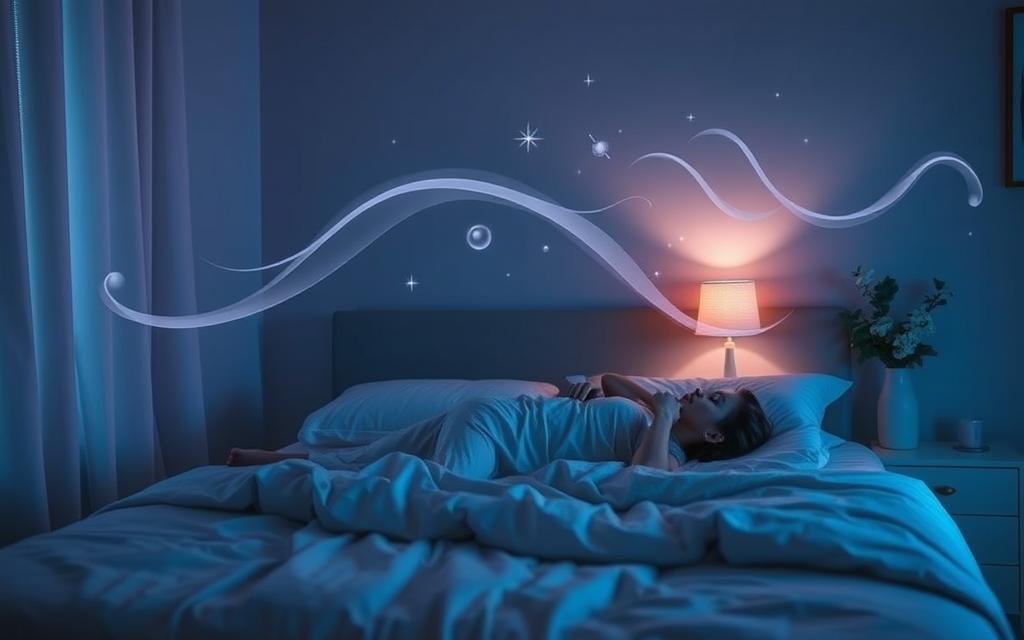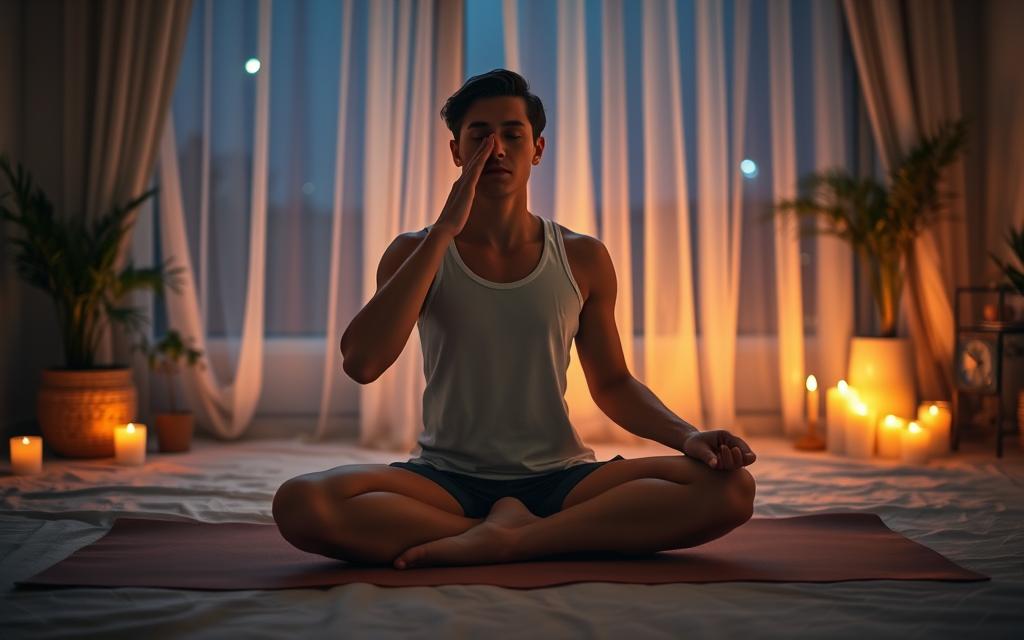As I lie awake, staring at the ceiling, the minutes tick by. I feel frustrated. Insomnia, that unwelcome guest, has visited my bedroom again. But tonight, I’m ready to take back my sleep. With a few simple breathing techniques, I’m sure I can say goodbye to restless nights and welcome peaceful sleep.
Insomnia affects millions of adults, making it hard to fall or stay asleep. Poor sleep can harm our physical and mental health. But, breathing exercises can relax our minds and bodies, leading to better sleep. In this article, we’ll look at techniques to help you fall asleep faster and improve your sleep quality.
Whether you face chronic insomnia or just occasional restless nights, these breathing exercises can help. They can change your bedtime routine for the better. Say goodbye to tossing and turning, and hello to restful, rejuvenating sleep.
Understanding Sleep Challenges and Their Impact on Health
Sleep disorders and poor sleep quality can harm our health and well-being. Many factors can cause these issues, like stress, anxiety, work pressure, financial worries, or jet lag. Not getting enough quality sleep can lead to problems such as irritability, fatigue, and trouble concentrating. It can also raise the risk of serious health issues like heart disease, depression, and sleep deprivation.
Common Causes of Sleep Difficulties
Stress and anxiety are big reasons for sleep troubles. When our minds are filled with worries, it’s hard to relax and sleep. Other factors like irregular sleep schedules, poor sleep hygiene, and medical conditions can also cause sleep problems.
Health Consequences of Poor Sleep
Poor sleep can have serious effects. It can make our thinking and decision-making worse. It can also increase the risk of chronic health issues like heart disease, stroke, and type 2 diabetes. It can make mental health problems like anxiety and depression worse.
The Role of Breathing in Sleep Quality
The way we breathe is key to good sleep quality. Slow, deep breathing can help reduce stress and anxiety. It can also increase melatonin production and calm the nervous system. This is important for getting restful, quality sleep. Understanding this connection can help us tackle our sleep challenges.

The Science Behind Breathing Exercises for Sleep
Breathing exercises deeply affect our sleep quality. They activate the autonomic nervous system and encourage the parasympathetic response. This helps lower stress hormones like cortisol, slows down the heart rate, and gets the body ready for sleep.
Studies reveal that deep breathing can greatly enhance sleep quality. It increases the time spent sleeping and reduces time spent awake during sleep. On the other hand, forced deep breathing can have negative effects, making it harder to fall asleep and decreasing sleep quality.
“Breath rate lower than the usual rate can promote parasympathetic activity, improving sleep drive.”
The parasympathetic nervous system is key in this process. It helps with relaxation and digestion. Slower and deeper breathing activates this system, reducing anxiety and stress.
Methods like diaphragmatic breathing, box breathing, and alternate nostril breathing are effective. They trigger the parasympathetic response, improving sleep, lowering cortisol levels, and boosting mental clarity. Regular practice of these exercises can greatly benefit overall health and sleep.

Understanding how breathing affects sleep can help improve sleep quality. Breathing exercises can be a powerful tool for better health and sleep.
Benefits of Nighttime Breathing Techniques
Adding nighttime breathing exercises to your sleep routine can bring many benefits. It can help lower stress and anxiety and boost your physical and mental health. These easy techniques can greatly improve your sleep quality, helping you fall asleep quicker and sleep longer.
Stress Reduction Effects
Doing breathing exercises before bed can be a great way to reduce anxiety and relaxation. Deep breathing activates the parasympathetic nervous system. This system helps your body relax and digest, lowering heart rate, blood pressure, and stress hormones.
Physical and Mental Health Improvements
Good breathing habits can also improve your physical and mental health. Nighttime breathing exercises have been shown to reduce depression symptoms and improve mood. They can also help your heart function better, lower blood pressure, and enhance overall well-being.
Impact on Sleep Quality
One key benefit of nighttime breathing exercises is their effect on sleep quality. They can shorten the time it takes to fall asleep and make sleep more efficient. By calming your body and mind, these exercises lead to deeper, more restful sleep. This can greatly improve your sleep patterns and daily life.
Adding nighttime breathing exercises to your routine is a simple way to better your sleep, reduce stress, and enhance your well-being. Try different methods, like the 4-7-8 breathing or diaphragmatic breathing, to find what works best for you.

Preparing Your Mind and Body for Sleep Exercises
Creating a good sleep environment is key for breathing exercises. Your bedroom should be cool, dark, and quiet. A regular bedtime routine tells your body it’s time to relax. Make sure you’re comfy, sitting or lying down, before starting.
Closing your eyes helps you focus on your breath. Doing these exercises at the same time every night makes them a habit. This can make them more effective.
Adding relaxation techniques to your routine can also help. Try visualization, progressive muscle relaxation, or self-hypnosis. These can calm your mind and body before sleep.
- Visualization can help you fall asleep quicker.
- Progressive muscle relaxation (PMR) relaxes your muscles by tensing and releasing them.
- Self-hypnosis can calm your thoughts and help you sleep.
By setting up a good sleep environment, following a regular bedtime routine, and using relaxation techniques, you’re ready for breathing exercises. They can greatly improve your sleep.

“Breathing exercises are not only helpful for sleep but also useful in managing stress during the day.” – Dr. Jade Wu, Ph.D.
The 4-7-8 Breathing Technique: A Complete Guide
If you’re having trouble sleeping, try the 4-7-8 breathing technique. Dr. Andrew Weil created it. It’s based on ancient yoga and helps you relax and sleep better.
Step-by-Step Instructions
To do the 4-7-8 breathing technique, just follow these steps:
- Exhale completely through your mouth, making a whoosh sound.
- Inhale through your nose for 4 seconds.
- Hold your breath for 7 seconds.
- Exhale through your mouth for 8 seconds, making a whoosh sound again.
- Repeat this cycle 4 times initially, gradually increasing to 8 repetitions.
Tips for Maximum Effectiveness
- Practice the 4-7-8 technique twice daily, once in the morning and once before bed, to reap the full benefits.
- Maintain the 4-7-8 ratio even if you need to count the seconds faster. The key is in the proportions, not the absolute time.
- Keep your tongue positioned behind your upper front teeth throughout the exercise.
- Combine the 4-7-8 technique with other relaxation practices like yoga or meditation for enhanced effectiveness.
By adding the 4-7-8 breathing technique to your daily routine, you can use pranayama to improve your sleep and well-being. Remember, regular practice is essential to get the most out of this simple yet powerful method.

Diaphragmatic Breathing for Deep Sleep
Looking for a simple way to better your sleep? Try diaphragmatic breathing, also known as belly or abdominal breathing. It works by engaging the diaphragm muscle, the main muscle for breathing.
To do diaphragmatic breathing, lie on your back with your knees bent. Put one hand on your chest and the other on your stomach. Breathe in through your nose, letting your stomach rise while keeping your chest still. Then, exhale slowly through pursed lips. This strengthens the diaphragm, slows your breathing, and lowers oxygen demand, helping you relax and sleep better.
Research shows belly breathing boosts sleep quality. It improves overall quality, sleep latency, and daytime function. Nurses who used this technique saw less anxiety, depression, and insomnia.
“The use of abdominal breathing can be a game-changer for those struggling with sleep difficulties. It’s a simple, natural technique that anyone can incorporate into their bedtime routine.”
For best results, practice diaphragmatic breathing for 5-10 minutes, 3-4 times a day. Start with short sessions and increase them. Aim for a breathing rate of 10 breaths per minute, with 3-second inhalations and exhalations. This helps deepen relaxation.

Adding diaphragm muscle exercises to your routine can greatly improve your sleep. Try it and see how it changes your sleep and overall health.
Alternate Nostril Breathing Exercise for Sleep
Alternate nostril breathing, or Nadi shodhana pranayama, is a yoga method. It balances the brain’s left and right sides. This can lower stress and help you relax, which might make you sleep better.
Proper Technique and Practice
Start by sitting quietly in a calm place. Close your right nostril with your thumb and breathe in through your left. Then, block your left nostril with your ring finger and breathe out through your right.
Switch it up by breathing in through your right nostril and out through your left. Do this for 5-10 minutes before you go to bed.
Benefits for Sleep Quality
Doing alternate nostril breathing regularly can improve your sleep. It helps reduce stress and makes you feel calm. This is great for those who have trouble sleeping.
“Alternate nostril breathing is a powerful tool for balancing the nervous system and inducing a state of deep relaxation, leading to better sleep quality.”
Adding this exercise to your bedtime routine can help you fall asleep quicker. You might also sleep more soundly and without interruptions.

Box Breathing: A Simple Yet Effective Method
If you’re dealing with stress or sleep problems, try box breathing. It’s a simple meditation that shapes your breath into a “box.” This can greatly improve your well-being.
To do it, breathe in for 4 seconds, hold for 4, then exhale for 4, and pause for 4. This pattern can calm you down and help with stress management and improving sleep quality.
- Box breathing can make you feel relaxed and in control in just 30 seconds.
- It’s great for handling panic, insomnia, and hyperventilation.
- Box breathing is easy to do anywhere, making it a handy meditation technique for any situation.
Using box breathing before bed can really help. It relaxes you and calms your nervous system. This can make you fall asleep quicker and sleep better. Studies show it can also improve your heart rate, blood pressure, and mood, all key for good sleep.
“Box breathing has gained popularity among professionals like Navy SEALs and police officers for its potential to enhance performance and reduce stress levels.”
Looking to manage stress, sleep better, or just find calm? Try box breathing. It’s simple and has many benefits, making it a great addition to your daily routine.
Bhramari Pranayama: The Humming Bee Breath
Bhramari Pranayama, also known as the Humming Bee Breath, is a calming yoga breathing technique. It helps with stress relief and improves meditation. This ancient practice is named after the black bumblebee in India, where “bhramara” means “big black bee.”
How to Perform the Exercise
To practice Bhramari Pranayama, sit comfortably with your eyes closed. Cover your ears with your hands, then breathe in deeply through your nose. As you exhale, make a gentle humming sound, almost like the buzzing of a bee. Repeat this cycle for about 5 minutes, focusing on the calming effect of the vibrations.
Scientific Benefits
Research shows that Bhramari Pranayama can quickly reduce both breathing and heart rate. This promotes a state of deep relaxation. The humming sound and ear coverage help block out external stimuli, allowing for better focus and stress reduction.
Regular practice of this technique can significantly improve sleep quality and reduce insomnia symptoms. Bhramari Pranayama is known to stimulate the vagus nerve. This nerve plays a key role in the parasympathetic nervous system and the body’s relaxation response. The practice can also enhance heart awareness and support overall well-being.
“Bhramari Pranayama is one of my favorite techniques for meditation due to its humming effects on sense withdrawal and concentration.”
Whether you’re looking to unwind after a long day or deepen your meditation practice, incorporating Bhramari Pranayama into your routine can be a powerful tool. It promotes yoga breathing, stress relief, and overall well-being.
The Buteyko Breathing Method
If you’re having trouble with sleep apnea or breathing issues at night, try the Buteyko Breathing Method. It was created by Dr. Konstantin Buteyko. This method helps you breathe through your nose and breathe less to sleep better.
This technique is based on the idea that bad breathing can cause health problems, like sleep apnea. It teaches you to breathe slower and less deeply. This helps keep your airway open while you sleep and lessens sleep apnea symptoms.
To do the Buteyko Breathing Method, sit comfortably and breathe through your nose for 30 seconds. Then, take a bit deeper breath, pinch your nose, and hold until you need to breathe. Start breathing normally again and do this a few times.
This exercise aims to change how you breathe and increase CO2 in your blood. This can help you sleep better. Research shows it’s great for sleep apnea, making episodes less frequent and less severe.
“The Buteyko Breathing Method has been shown to help reduce asthma symptoms, anxiety, and sleep apnea.” – American Sleep Apnea Association
Improving sleep is just one benefit of the Buteyko Breathing Method. It can also lower anxiety, improve heart health, and boost athletic performance. It’s a simple yet powerful technique for better health and well-being.
Remember, the Buteyko Breathing Method is not a cure-all. It’s a helpful addition for those with breathing sleep disorders. Always talk to a doctor before starting any new breathing exercises or sleep techniques.
Creating a Bedtime Breathing Routine
Starting a bedtime breathing routine can really help your sleep. Try to do your breathing exercises at the same time every night, 30-60 minutes before bed. Begin with 10-20 minutes and add more as you get better at it.
To make your breathing routine perfect, create a calm and relaxing atmosphere. Turn down the lights, quiet any loud noises, and keep the room cool. Mix your breathing with other relaxation techniques like stretching or meditation for the best results.
Timing and Duration
Being consistent is crucial for a good bedtime breathing routine. Make your body link these exercises with sleep and relaxation by doing them at the same time every night. Start with 10-20 minutes and grow the time as you get more comfortable.
Environmental Considerations
- Dim the lights to create a soothing, circadian rhythm-friendly environment.
- Reduce any external noises that could disrupt your relaxation and focus.
- Maintain a cool room temperature, as this can help facilitate better sleep quality.
- Consider incorporating other calming elements, such as soft music or aromatherapy, to enhance the overall sleep-promoting atmosphere.
By setting up a regular bedtime routine and making your environment relaxing, you can use breathing exercises to better your sleep and overall health.
Common Mistakes to Avoid When Practicing Breathing Exercises
Adding breathing techniques to your daily routine can boost sleep, lower stress, and improve health. Yet, it’s key to steer clear of common errors that can lessen their benefits. By sidestepping these mistakes, you can get the most out of these exercises and enjoy a better experience.
One frequent error is trying too hard. Straining during breathing exercises can raise tension and hinder relaxation. It’s crucial to strike a balance between focus and ease. Don’t be too relaxed, as focus helps distract from stress. Yet, avoid being too stiff.
Another common mistake is rushing through the exercises. Breathing techniques work best when you allow yourself to fully immerse in the sensations. Take your time and let the exercises do their job.
- Avoid practicing in a distracting environment. Seek a quiet, cozy spot where you can concentrate without interruptions.
- Don’t expect immediate results. The effects of breathing exercises grow with regular practice. Be patient and trust the process.
- If you feel lightheaded or uncomfortable, go back to normal breathing. If symptoms last, talk to a healthcare expert.
By being aware of these common errors and adjusting your practice, you’ll unlock the full benefits of breathing techniques. This includes improving sleep, reducing stress, and enhancing overall health and well-being.
Conclusion
Breathing exercises are a natural way to improve sleep and reduce insomnia. Techniques like the 4-7-8 method and Bhramari Pranayama are great for different needs. Regular practice can help you fall asleep faster and sleep better.
If you have ongoing sleep problems, talk to a healthcare professional. With effort, these breathing exercises can greatly improve your sleep. This is key for your health and well-being.
Using sleep improvement strategies like breathing techniques and relaxation methods can make a big difference. By practicing regularly, you can use your breath to improve your sleep. This can greatly enhance your life’s quality.
